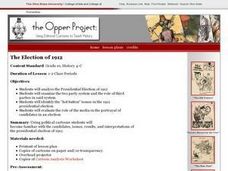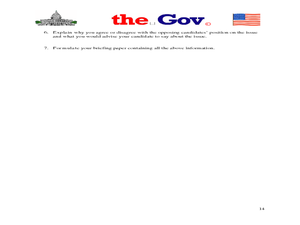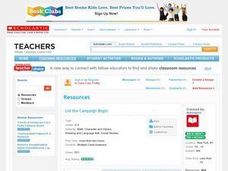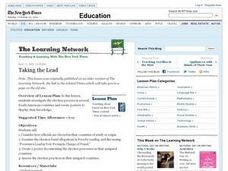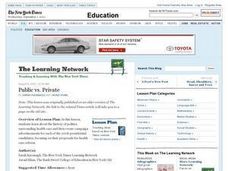Curated OER
The Election of 1912
Tenth graders examine the Election of 1912. In groups, they identify the roles of the Democratic and Republican parties along with any third party mentioned. Using the internet, they describe the main issues of this election and discuss...
Curated OER
Election Scavenger Hunt
Students examine newspapers and other resources for articles about the election. They collect articles and photos from both presidential candidates. They also search for political cartoons and discuss what they find.
iCivics
Cast Your Vote
Impress upon your learners the importance of researching candidates in an election and considering not only which issues are most important to them as voters, but also which issues are most important to the candidates.
C-SPAN
Student Symposium and Resulting Action
Your class may not be able to vote yet, but that doesn't mean they can't feel like they're part of the presidential election! The resource creates a symposium where pupils debate about a selected topic in current events during an...
Curated OER
The California Recall Election
Learners identify facts about the structure of the California recall election. They research the history of recall elections throughout the United States. They analyze the positives and negatives of a governor recall election.
Carolina K-12
Exploring the Electoral College
Does your vote really count? This activity helps young voters learn about the electoral college through a TED talk, a helpful handout, discussion prompts, and then a role-playing activity that has participants simulating...
Curated OER
Voter Turnout
Explore politics by analyzing the voting process. Pupils discuss the purpose of casting votes in an election, then examine graphs based on the data from a previously held election's turnout. The lesson concludes as they answer study...
Curated OER
The Battle for Congress: Midterm Elections 2010
Students research midterm elections. In this United States Congress lesson, students use the Internet to explore the issues, candidates, platforms and stakes of the midterm elections of 2010. This extensive lesson makes use of...
Curated OER
"The Election"
Students participate in an election for the purpose of comprehending the political process and the responsibilities that come with citizenship in a free society. They elect officials with no identity and are surprised with the revealing...
Carolina K-12
Propaganda, Spin and Soundbite Politics
It's all about the spin! In an introduction to propaganda techniques and soundbite politics, scholars first learn about common propaganda techniques before seeing them in action in the context of the 2016 election cycle. Activities...
Carolina K-12
Preventing Voter Fraud or Encouraging Voter Suppression?
The issues of voter fraud and voter suppression are relevant in every election, local as well as national. Soon-to-be voters learn about a recent bill proposed in North Carolina, the Voter Information and Verification Act, and...
Curated OER
Let the Campaign Begin
Students examine the many steps involved in the electoral process. They examine past president's campaigns and write an announcement speech for the candidate of their choice.
PBS
Analyzing the Candidates in the 2008 Presidential Election
High schoolers research the 2008 presidential candidates and the required process for becoming an American presidential candidate. The class discusses both the process and the candidates, and some of the reasons someone might want to run...
Curated OER
Taking the Lead
Students discover how officials are elected in countries of interest to them. After reading an article, they examine election fraud allegations in Peru. They create a poster showing the election process and assess them in a written essay.
Carolina K-12
Compulsory Voting
Should voting in the United States be compulsory? In 2004, fewer than 60 percent of eligible voters cast ballots in the American national elections. After reviewing arguments for and against compulsory voting, your young citizens will...
Curated OER
Watching the Elections
Learners analyze the media products and advertising techniques used in political campaigns. In this elections lesson, students view political debates and then work in groups to find examples of types of advertising techniques used in...
Curated OER
Public vs. Private
Young scholars watch two commericals from previous presidential elections on the topic of healthcare. After reading an article, they identify the position of the various candidates for the 2008 election. In groups, they brainstorm their...
Curated OER
Analyzing Free and Fair Elections
Young scholars brainstorm the qualities of a "free and fair" elections. They read background information pertaining to the upcoming 2007 presidential elections. Pupils compare the "free and fair" elections list composed by students to...
Curated OER
Evaluation of Election Process
High schoolers examine the procedures to elect the President of the United States. In groups, they create their own political cartoon presenting a consensus of their point of views on the process. They identify the strengths and...
Curated OER
The 2004 Presidential Election
Students examine the 2004 Presidential election between George W. Bush and John Kerry. Using a variety of primary source documents, they discover where the candidates stood on the issues. In groups, they create a tableau in which they...
Curated OER
Choose or Lose: The Electoral Process
Learners examine the local and national election process. In groups, they brainstorm a list of the issues important to them and compare them to an overall list of issues present in the election. They analyze graphs and complete...
Curated OER
Presidential Election 2004: Analyzing the Attack Ads
Students view and text the text of presidential election advertisements in 2004. Using the ads, they analyze them and check the validity of the statements made. They answer discuss questions for each ad and share them with the class.
Curated OER
Lose a Vote, Gain a Vote
Students explore the issues behind close Senatorial races. They investigate the qualities of political leaders, the 2002 senatorial elections and the differences and similarities between the Republican and Democratic parties.
Curated OER
Introducing Elections Unit
Students discover the political parties of our country by participating in a role playing activity. In this U.S. Government lesson, students visit several different classrooms that each represent one of the political parties in the...
